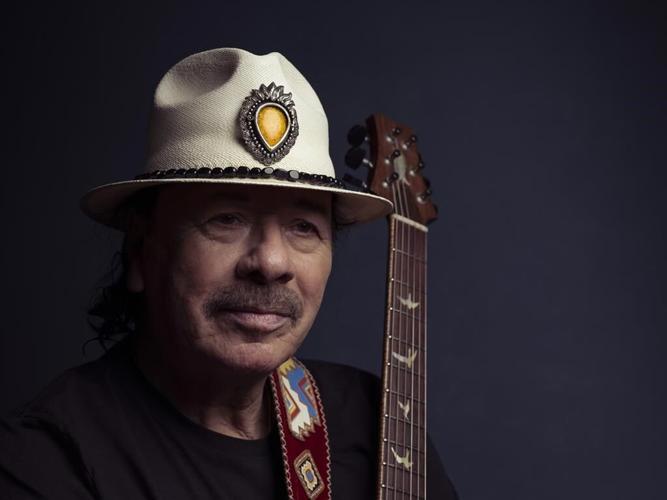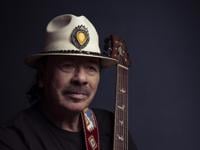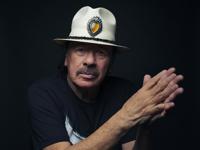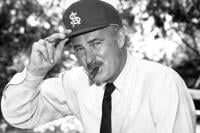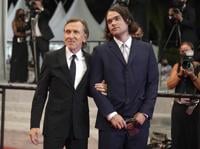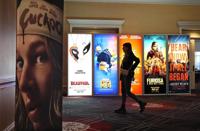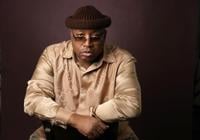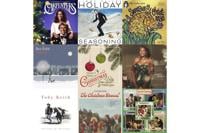NEW YORK (AP) — “Take no prisoners — peacefully,” Carlos Santana sometimes tells his bandmates before taking the stage.
“I don’t like to coast. I don’t like to rope-a-dope,” Santana says. “I want to get in the middle of the ring and knock the sucker out. That way the referee can’t steal the fight from me.”
Santana, 75, can still whip a crowd into a frenzy like few others. He’s been doing it since he stormed onto the San Francisco scene in the late ’60s. He left the Woodstock audience dazed and stunned before the first Santana record came out.
The new documentary by Rudy Valdez, which is premiering at the Tribeca Film Festival and will be released this fall in theaters by Sony Pictures Classics, chronicles the meteoric rise of one of the most singular guitar players in rock history. The critic Robert Christgau once wrote: “He is less a man of style than of sound, a clear, loud, fluent sound that cleanses with the same motion no matter how often that motion is repeated.”
Santana, who launches in Newark, New Jersey, on June 21, recently spoke by Zoom from his Bay Area home in California. He’s been in San Francisco since his family (his father played the violin in a mariachi band) moved from Mexico in the 1960s.
“The Bay area definitely attracts characters, you know?” said Santana. “Like Minnesota Fats or Les Paul. Rascals. I call them Divine Rascals.”
Santana, speaking with a panoramic photograph of the Woodstock performance hanging on the wall behind him, reflected on his journey, his sound and some of the demons he’s faced along the way.
“I have nothing but good memories,” said Santana. “I have developed selective celestial amnesia.”
___
AP: How was it to watch a movie of your life?
SANTANA: It’s strange. It’s interesting to watch this person constantly strive and believe that he belongs. Ha ha! That he belongs on stage with these incredible musicians. Who would have thunk it that one minute I’m washing dishes at Tic Tock (Drive-In) and the next I’m on stage with Jerry Garcia and Eric Clapton and they’re looking at me like I definitely got something they want to learn from? They’d all go, “Where did you get that?” And I’d say, “Well, when you were listening to this, I was listening to a Hungarian gypsy musician named Gábor Szabó.” And also drummers. I learned a lot from African drummers. So I learned how to scramble the eggs differently. The guys from Creedence Clearwater used to say: “What is it you call that music you’re playing?” And I go, “African rhythms with blues guitar.”
AP: There are many enduring relationships you have in “Carlos” but how would you characterize your relationship to the guitar?
SANTANA: My guitar is my best lover, ever. Lovers come and go, but your relationship with the guitar — any brand or anything — stays. But it’s your relationship with that sound. When you put your fingers on that note, you get chills. That’s the best lover. You discover the sensation of getting the first French kiss. I’ll stop there because this should be PG. But it all deals with the same thing. It all deals with “Oh my God.” The big G-spot, which is God. When you hit that, they all go, “Oh my God.” When you play music like that, it’s more than just clever notes. It becomes emotion, feelings, passion. That’s music to me. Music without emotion, passion or feelings is just clever noise.
AP: You have always had a distinct, instantly recognizable guitar sound, like a voice. Where did your tone come from?
SANTANA: I used to lock myself in a closet in the dark and try to play like B.B. or Otis Rush, all the people that I love. And it used to frustrate me that I couldn't sound like that. Then one day I woke up and I go, “Hey, stupid. You’re not supposed to sound like them. They sound like them. You’re supposed to sound like you.” Then you realized: “How do I play like me?” Just shut up and play. Right now, I’m only listening to three things: Nina Simone, Etta James and Tina Turner. I want that sound that those women get in my guitar. I want my guitar to sound like a woman.
AP: In the film, you recount how Jerry Garcia gave you mescaline shortly before you took the stage at Woodstock, thinking you had hours before you performed. In arguably the most celebrated set of Woodstock, you were tripping and praying...
SANTANA: “God, please let me stay on tune and in time.” I could have laid a big egg in front of everybody. It was scary to look at the audience. But what came through was my mother’s confidence: God is by your side. How can you go wrong?
AP: In the film you talk about about being molested from the ages of 10 to 12. Did music bring some measure of healing from
SANTANA: All I can say with certainty and clarity is: I am not what happened to me. I still am, as God created me, with purity and innocence. I have a habit of sending people to the light instead of the hell. I used to say, “Eat s—- and die.” But I don’t say that anymore. Now I go: You know what? I’m going to look at you like you’re seven years old. And I’m going to send you into the light that is behind you. If I send you to hell, then I’m going to go there with you. And I don’t want to go to hell. By doing that, I’m able to not be stuck with the victim mentality. “I’m Santana and I was a victim of child molestation” — I don’t want to do that. I don’t want to think like that. I’m Carlos Santana and by grace I can create blessings and miracles.
___
Follow AP Film Writer Jake Coyle on Twitter at:

